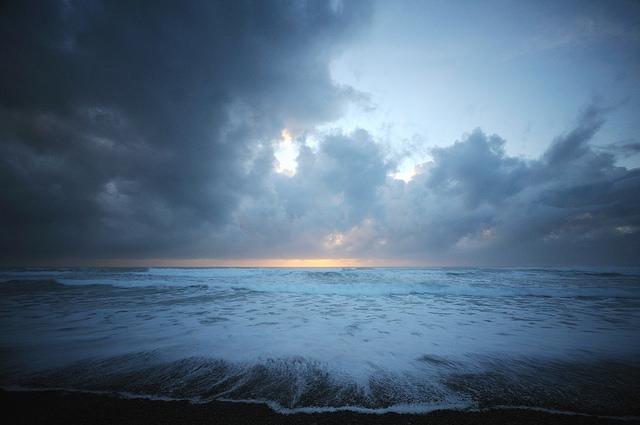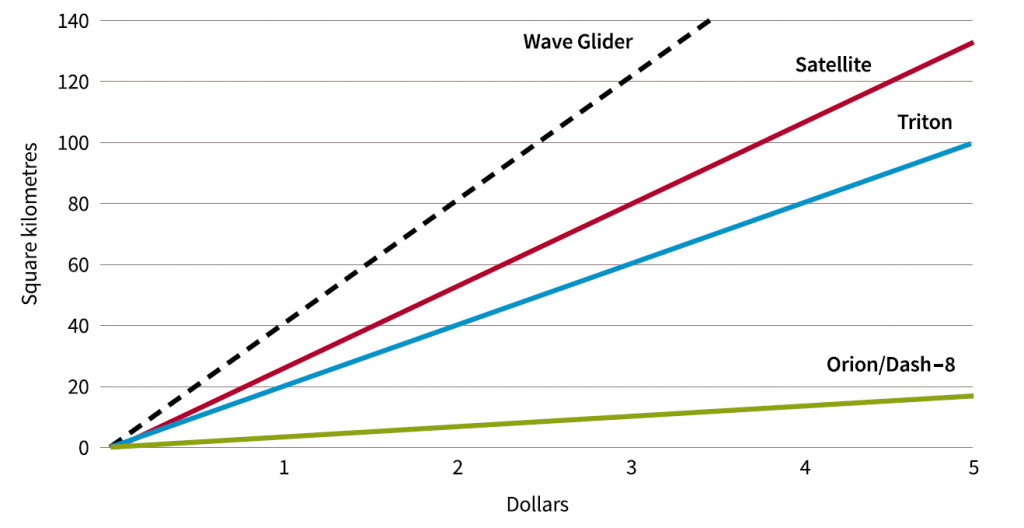
The volume of traffic travelling through Australia’s maritime approaches—along with a diversifying threat environment—is putting ever-increasing strain on border security assets. In the coming years, Maritime Border Command will come under pressure to capture, filter, monitor and respond to increasing volumes of information in order to more effectively address maritime security threats. And in a budget-constrained environment, that’ll require the adoption of more inventive and efficient strategies.
Utilising developments in unmanned technology, an opportunity exists for Australia to transform its maritime domain awareness (MDA) strategy into something like this view of the future:
…a net of several hundred solar- and wave-powered unmanned maritime vehicles (UMVs) stretch across Australia’s northern approaches. Those highly autonomous surface vessels communicate and coordinate their movements to stay on station or move out of the way of passing vessels. Every day, the UMVs’ sensors detect and monitor dozens of ships entering and exiting Australian territory.
In this hypothetical future, all of the unmanned assets feed their surveillance data to an intelligence fusion centre at MBC, which integrates the information with satellite imagery and automatic identification system feeds. In real time, an MBC analyst can obtain a video feed from any of the hundreds of UMVs spread across Australia’s EEZ. This provides a team of MBC analysts with a detailed and up to date operating picture, enabling them to identify suspicious activity in Australian waters.
Big data analytics augment that effort by collating and fusing various other data feeds with real time UMV surveillance data to flag potential threats. Maritime commerce continues none-the wiser to the presence of Australia’s MDA system.
Large vessels not using automatic identification systems (AIS) are detected by strategically stationed UMVs, assigned to guard valuable marine reserve areas. If there are no manned patrol boats within a reasonable distance, a forward-deployed, high-speed UMV is engaged by MBC and sent to examine the vessel more closely.
Once identified, a decision is made as to whether the vessel poses a risk and whether it’s worth sending a manned patrol boat to intercept and disrupt the offending vessel. The networked system of systems with its unmanned technologies means Australian border protection efforts are an exercise in efficient risk-management…
This isn’t science fiction; all of those technologies exist in one form or another today. Australia has the opportunity to make that scenario a reality for its MDA strategy. But to do so, MDA capability developers need to embrace new thinking about UMV technology and their deployment.
At present, broad maritime surveillance is conducted by a small number of highly capable yet expensive assets such as manned patrol boats or aircraft. UMVs should be considered as a force multiplier for those assets, rather than a replacement. The highly autonomous and energy-efficient operation of those platforms means surveillance efforts can be performed at a much lower cost than by other sophisticated, manned assets. Figure 1 demonstrates the low cost per square kilometre surveilled by a Wave Glider UMV, compared to other MDA assets.
Figure 1: Cost ratios of MDA platforms

For example, a large network of UMVs could be permanently stationed in high traffic areas of Australia’s maritime jurisdiction to perform broad area search and detect functions. The high autonomy and low power requirements of those UMVs means that large areas of Australian maritime jurisdiction can be kept under persistent surveillance. As a result, the likelihood of a threat passing through undetected is greatly decreased.
Importantly, UMV intelligence collection will also enhance risk-based decision-making. Having a more accurate operating picture will enable MBC personnel to assess the threat profile of a vessel before deciding on an appropriate response. Strategic placement of those platforms will facilitate a more proportional response strategy. Namely, more sophisticated and expensive assets are deployed in response to only the most serious of incidents, or when their capabilities make them indispensable.
The potential of this technology isn’t limited to surveillance, however. With appropriate research and investment, UMVs could evolve to support more substantial portions of border control processes. There are several models of high-powered—but still energy-efficient—UMVs, which could support the tracking of an offending vessel, for example. Forward deployment of those unmanned assets improves the quick response capabilities available to MBC.
Investing in the continual development of unmanned technologies, and partnering with the private sector are important steps towards helping Australian border protection efforts keep pace with the changing threat landscape. Australian leadership in this field could also support the development of Australian industry and potentially generate a lucrative export industry.
Today, ASPI’s Border Security Program is launching a new Special Report, Australian Border Security and Unmanned Maritime Vehicles. Learn more about our current border security capabilities and the important role UMVs could play in the future of Australian border security by reading the full report here.